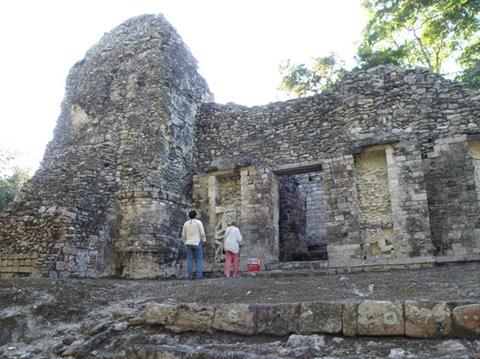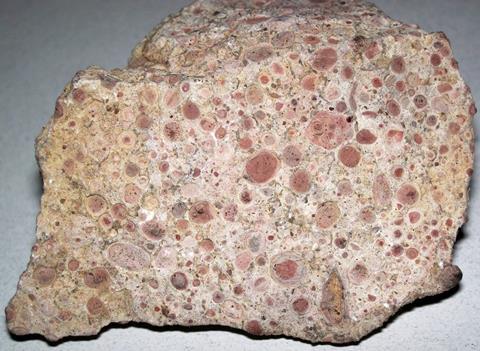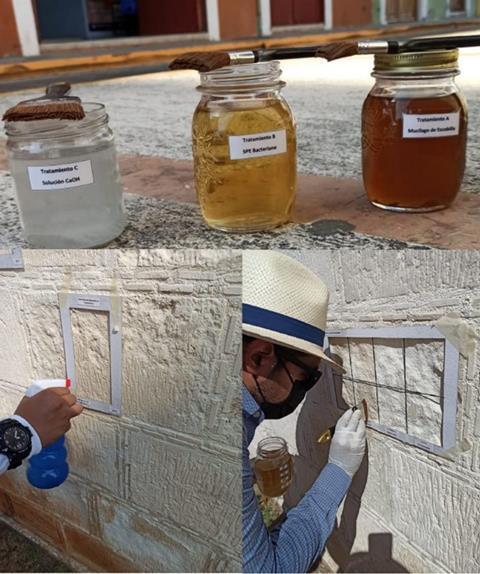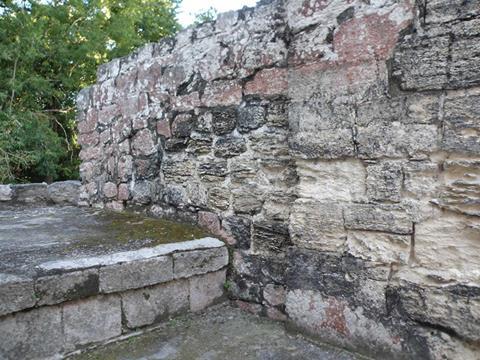Historical monuments are the most evident manifestations of a people’s cultural legacy. In Mexico, Mayan archaeological sites stand as some of the most significant cultural examples in the Western hemisphere, now constituting part of the international historical heritage.
“…Then he shall go in himself to see the leprosy of the house, and he shall see that on the walls there are depressions of a pale or reddish color deeper than the rest of the surface…” - Leviticus 14:36, 37
Chichen-Itza and Uxmal in Yucatan; Calakmul, Edzná and Becán in Campeche as well as Bonampak and Palenque in Chiapas, are some of the most representative archaeological sites of this civilization. These monuments as human constructs, similarly to landforms (i.e. cliffs, rocky shores) are prone to weathering and erosion, associated with chemical, biological, and physical agents, often operating in a synergistic manner. In addition, many of the cultural resources suffer from serious deterioration enhanced by human impact, either through direct deterioration by visitors and/or lack of funding to implement appropriate conservation practices. This situation has sparked the interest and action of several concerned assemblies, ranging from governmental entities, local civic and tourism associations, and research groups in studying, maintaining, and preserving such cultural resources.

Stone biodeterioration
Mayan constructions, in particular, are exposed to environmental conditions characterized by cyclic changes in high temperatures and high humidity, both of which directly and indirectly contribute to the degradation of these relics. The primary material used for building these structures is limestone, a highly porous and mechanically weak material, which has led to numerous cases of deterioration in Mayan sites. The main causes of degradation after excavation of the monuments are the inherent mechanical weakness of the stone, cyclic temperature and humidity changes, and active microbial growth. Microbial activity is considered one of the most significant factors in the destruction of stone materials. Subaerial biofilms are microbial communities that colonize solid surfaces exposed to the atmosphere. Subaerial biofilms associated with rock substratum colonize surfaces as epilithic growths and as endolithic communities grow within fissures, cracks, and pores in the rock matrices. The extent to which surfaces are colonized by microbes depends on climatic parameters (e.g. temperature, light, and humidity), the composition of the mineral substrate, and its intrinsic properties.
The first studies to characterize microbial communities on Mayan monuments were based on culturing. Cyanobacteria were reported to be prevalently associated with the deterioration of the construction material of the Great Pyramid of the Jaguar in Tikal, Guatemala, in 1993. Subsequent studies focused on using a culture-independent approach, namely lipid biomarkers together with scanning electron microscopy, allowed the detection of cyanobacteria, fungi, and sulfate-reducing bacteria in 2000. Later, with the advent of molecular biology methods, a deeper insight into the complexity of these communities was achieved, allowing the description of extremophilic bacteria of the genus Rubrobacter, Salinibacter and Euhalothece, which by the time of reporting in 2004, was somewhat surprising, but made sense when analyzing the chemistry of the underlying substratum, finding large amounts of salts. In fact, salting of stone and microbial colonization is a common phenomenon in Mayan buildings.

Mayan dynastic texts and stelae are among the most affected structures due to surface degradation, resulting in loss of engravings and valuable information. Scanning electron microscopy (SEM) analysis of various samples of construction stone from Mayan temples and pyramids in Uxmal revealed a semi-porous texture with crystalline grains forming the inorganic matrix. Numerous studies discuss the mechanisms of microbial stone biodegradation, and it has been generally recognized that these mechanisms are complex and not fully understood. However, some of the most significant factors include the secretion of organic acids such as oxalic, citric, and uronic acids as well as inorganic acids like sulfuric and nitric acids. The production of these metabolites can lead to acidification and/or chelation of cations (e.g. Ca²⁺ and Mg²⁺), promoting the dissolution of certain minerals and deteriorating the stone. Biofilm exopolymeric substances allow microorganisms to adhere to surfaces; these compounds also may contribute to stone degradation (but also protect), chemically interacting with minerals and causing dissolution. Similarly, these organic substances, by forming dense layers, act as mechanical barriers that block pores, retain moisture, and prevent evaporation. The resulting high humidity conditions facilitate the establishment and growth of various microbial groups with different metabolic types, which synergistically initiate, promote, or magnify stone deterioration processes.
Protection and preservation of monuments
Given the cultural significance of these monuments and their current state of deterioration, recent years have witnessed studies aiming to protect and preserve them. Firstly, it is necessary to gain insight to identify the main microorganisms involved in the biodeterioration phenomenon and understand their mechanisms of action. Subsequently, methods of protection are evaluated, such as the application of biocides and polymeric consolidants. The determination of the protective efficiency of these compounds is initially conducted in a laboratory setting, under controlled conditions of temperature, humidity, nutrients, and light. Stone specimens are chosen, representing the mineralogical composition and physical characteristics of the monument under study. The evaluation involves applying various formulations under these conditions, inoculating the samples with strains of microorganisms previously isolated from the investigated sites. The protective capacity of the different studied systems is calculated using a range of analytical methods. Formulations that prove most effective in the laboratory are then evaluated under natural conditions, and their efficiency is monitored.
However, it has been generally observed that some highly efficient biocides are very toxic for handling and have environmental restrictions. On the other hand, the application of consolidants has shown that some of them do not adhere properly to the stone and can even induce aesthetic changes. Another drawback in their application is that most consolidants are attacked by microorganisms, leading to the current trend of conducting protection studies that assess mixed formulations of biocides and consolidants.

Nanoparticles (NPs) have recently received attention from the conservation and restoration communities as alternatives to biocides. Nanomaterials have both photocatalytic and catalytic properties, which were first used for the consolidation of degraded stone or to enhance the properties of painted walls. TiO2 NPs are the most studied type of NPs displaying biocidal properties. Comparatively, little is known about the potential of Cu and Zn NPs, although they appear to be particularly useful for indoor surfaces lacking light. There are no clear specific activities against microbial groups, as several NPs appear to exert toxic activity using similar modes of action.
Traditional conservation treatments are also gaining renewed interest, as they are recognized as a more environmentally acceptable choice. Biologically based stone restoration treatments include lime-based mortars combined with vegetable biopolymers. The reported biopolymers are derived from Aloe vera, Cylindropuntia californica, Opuntia engelmannii, Opuntia ficus-indica, Salvia hispanica and Sida angustifolia. Biopolymers are obtained through various extraction procedures, soaking leaves and other leaf tissues in batches of water and subsequently allowing them to be released into bulk water. This water containing the biopolymers is then mixed with lime and other materials and is used for consolidation or as a suspension. The consolidants are then applied to the stone surface using techniques such as spraying, brushing or partial immersion, or mixed with other materials to produce compounds.

Microbial bioconservation of stone
Microbial communities colonizing stone surfaces are complex, despite the stone habitat being often considered oligotrophic. Current studies in other countries besides Mexico refer to stone microbiome. The geochemical significance of epilithic microbial communities has recently been recognized to be acting on both sides: deterioration and protection. Thus, the relevance of biological impact to the entire deterioration process should be evaluated very carefully. Detecting microorganisms on heritage objects does not necessarily imply a deteriogenic impact on the chemical composition or physical properties of the materials. In fact, recent studies have shown that subsets of the stone community such as biocarbonatogenic bacteria and EPS-producing organisms may contribute to stabilize degraded surfaces, providing cohesion of disaggregated particles/grains.

The use of biological organisms in the treatment of degraded stone is relatively new. Biotechnology is an innovative area in the conservation of historic and artistic heritage and biotechnological approaches have only relatively recently begun to be used for the analysis of lithotrophic organisms suitable for use in conservation. The technologies include biomineralization, biocleaning and biomimetic surfaces. Consolidation of stone by biomineralization, in which microorganisms (most commonly bacteria) are impregnated into deteriorated stone and allowed to produce new lithic material, is a practice already used in both conservation-restoration and civil engineering.
Conclusions
The degradation of historical monuments is an extremely complex phenomenon, as multiple factors of a diverse nature come into play, often acting synergistically, at different time and space scales. Given this complexity, it is necessary to study it through various methodological approaches, drawing from disciplines such as microbiology, chemistry, geomorphology, materials science, archaeology and restoration science. Microbial biodegradation has proven to be one of the most significant causal factors in the deterioration of historical monuments. The macro- and microenvironmental conditions of the Yucatan Peninsula, along with the inherent characteristics of limestone, facilitate the colonization and microbial activity in ancient Mayan structures, leading to their deterioration. Nevertheless, new evidence shows that microbial communities may, under certain circumstances, contribute to the protection of stone through biocalcification or EPS biostabilization at least in the short term. It is tempting to believe that as greater understanding of the composition, physiology and biogeochemical influence of these peculiar microbial communities is achieved, we, as humans, will be able to manage them to develop microbial services to enhance the protection of our valuable cultural assets.










No comments yet